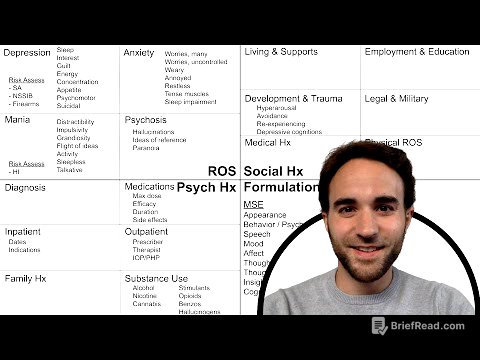TLDR;
This book provides a practical guide to understanding and managing emotions, overcoming negativity, and improving overall well-being. It emphasizes the importance of self-awareness, challenging negative thought patterns, and conditioning the mind for positivity. The book also explores the impact of various factors, such as sleep, body language, and environment, on emotional states, offering actionable steps and exercises to foster personal growth and emotional mastery.
- Understanding Emotions
- Overcoming Negativity
- Personal Growth
Introduction [0:10]
The author shares their initial excitement and subsequent struggles while writing a book about mastering emotions, admitting to experiencing their own emotional challenges during the process. The author highlights the universality of negative emotions and the importance of learning from them rather than being defeated by them. The author emphasizes that recognizing and acknowledging one's feelings is the first step toward emotional control, and that emotions significantly impact the quality of life, acting as guides for personal growth. The author finds it ironic that while most things come with a manual, the mind doesn't, and this book aims to serve as that instruction manual, teaching readers to overcome fears, manage negative emotions, and cultivate positive ones.
What You'll Learn [4:20]
The book is structured into four parts, each addressing different aspects of emotional mastery. Part one discusses the nature of emotions, focusing on negativity bias and the impact of beliefs. Part two explores factors that directly influence emotions, such as the body, thoughts, words, and sleep. Part three covers the formation of emotions and techniques for conditioning the mind for positivity. Finally, part four examines how to use emotions as tools for personal growth. The author encourages readers to revisit sections for deeper exploration and to apply the exercises provided, emphasizing that the book's effectiveness depends on the reader's effort and commitment.
How Your Survival Mechanism Affects Your Emotions [7:33]
The brain is wired for survival, prioritizing threat detection over happiness, leading to a negativity bias. This bias, evolved from ancestral needs to quickly identify and avoid dangers, still influences modern emotional responses, such as the fear of rejection. Although rejection rarely poses a survival threat today, the brain is programmed to perceive it as such, causing emotional pain and potential overreactions. Overcoming this bias requires reprogramming the mind to differentiate between real and imaginary threats, using thoughts to interpret events in a more empowering way.
Why Your Brain's Job Isn't To Make You Happy [11:10]
The brain's primary function is survival, not happiness, necessitating conscious effort to manage emotions for well-being. Dopamine, a neurotransmitter linked to pleasure and reward, plays a significant role in reinforcing behaviors necessary for survival, but can be artificially triggered by activities like social media, leading to addiction and unhappiness. This reward system, once vital for survival, is now exploited by marketers, creating a cycle of dopamine-driven addiction that undermines genuine happiness. The pursuit of happiness through dopamine can lead to harmful addictions, as demonstrated by studies where participants prioritized pleasure stimulation over basic needs like food.
What Is The Ego [17:49]
The ego, or self-identity, significantly shapes emotions and is constructed through thoughts and interpretations of life events. This identity is reinforced by external factors, such as identification with names, religions, political beliefs, and occupations, leading to emotional responses when these are challenged. Self-awareness is crucial in understanding and managing the ego's influence, with higher self-awareness enabling individuals to see through their ego and reduce suffering caused by excessive attachment to beliefs. The ego is a selfish entity focused on its own survival, driving individuals to seek achievements and recognition to strengthen its identity.
Your Ego's Need For An Identity [20:23]
The ego strengthens its identity through identification with physical items, the body, and relationships. Marketers exploit this need by associating products with emotions and stories, allowing consumers to enhance their status or express their personality through purchases. The ego also derives self-worth from physical appearance and relationships, seeking approval from others to reinforce its identity. This is evident in parent-child relationships, where parents may live vicariously through their children, and in couples, where the ego drives a need for someone else's company. Beliefs are also used by the ego to strengthen its identity, sometimes leading to extreme attachment and conflict.
The Ego's Main Characteristics [26:00]
The ego equates having with being, thrives on comparison, and is never satisfied, constantly seeking more fame, recognition, and possessions. It relies on external validation and the approval of others to feel valued, and seeks to feel superior to other egos by enhancing its value through associations, gossiping, and manifesting superiority or inferiority complexes. The ego loves to be right, often leading to complaining and seeking attention through various means, including fame, eccentric clothing, or even committing crimes. Understanding how the ego operates can help individuals better control their emotions by recognizing their story as a result of identification with external factors.
The Nature Of Emotions [29:51]
Emotions are transient and unpredictable, requiring acceptance of their impermanence to avoid self-blame and suffering. Negative emotions are not inherently bad or useless; they can serve as wake-up calls and opportunities for personal growth. Even the toughest individuals experience negative emotions, which often play a role in ultimate success. Emotions signal the need for change, prompting individuals to let go of harmful relationships, quit unsuitable jobs, or revise disempowering stories. Despite the fleeting nature of emotions, recurring negative emotions indicate underlying disempowering beliefs that need to be addressed.
The Trickiness Of Emotions [34:58]
Negative emotions act as filters, tainting experiences and altering perceptions, while positive moods enhance enjoyment and openness. Knowledge of emotional management does not eliminate negative experiences, but rather equips individuals to navigate them with greater wisdom. External factors often do not directly cause sudden emotional shifts; instead, internal dialogue and interpretations play a significant role. Emotions amplify thought patterns, making it challenging to break free from their influence, especially when they align with personal stories.
The Filtering Power Of Emotions [39:00]
Emotional states significantly affect one's outlook on life, influencing energy levels, confidence, and motivation. Positive states foster openness to new actions and perseverance, while negative states lead to a lack of motivation and a propensity for negative thoughts. Personal experiences illustrate how the same external conditions can elicit radically different actions based on emotional state. Emotions act like magnets, attracting thoughts on the same wavelength, creating vicious cycles between thinking and feeling.
Breaking The Magnetic Power Of Emotions [43:36]
To break the magnetic power of emotions, it is essential to remove the habit of clustering negative thoughts together and compartmentalize issues. Negative emotions exist only in the mind, and most issues are not overwhelming when taken separately. Individuals should start noticing and recording their negative emotions to uncover patterns and gain a deeper understanding of their triggers. Emotional accessibility is also crucial, as individuals cannot attract thoughts that are out of sync with their current emotional state.
Your Emotional Set Point [46:44]
The emotional state one is in limits access to other emotions, making it difficult to shift from negative to positive feelings directly. A model explains how emotional ranges are connected, suggesting that moving up the ladder from negative to positive emotions requires transitioning through intermediate states. Even so-called negative emotions like anger can help overcome more disempowering emotions like hopelessness. Mental suffering arises from interpreting emotions negatively, rather than from the emotions themselves.
Emotions And Mental Suffering [48:11]
Mental suffering, such as procrastination and dwelling on worries, consumes significant energy and contributes to exhaustion. Problems exist only in the mind, requiring attention and interpretation to be perceived as such. By refusing to interpret emotions negatively and focusing on the present moment, individuals can reduce mental suffering. Problems only exist when you give them your attention from your mind's perspective what you don't give any thought to doesn't exist.
What Impacts Your Emotions [52:57]
Emotions are influenced by various factors, including sleep, body language, thoughts, and words. While spontaneous emotional reactions exist, most emotions are self-created through the interpretation of thoughts and events. The quality of sleep significantly affects emotional state, with sleep deprivation increasing negative emotions and mortality risk. Improving sleep quality involves creating a dark, electronic-free bedroom, relaxing the mind, and establishing an evening ritual.
Using Your Body To Influence Your Emotions [58:58]
Body language and posture can alter emotions, with confident poses increasing testosterone and decreasing cortisol levels. Conversely, adopting a slouched posture and negative self-talk can create depression. Exercising improves both physical well-being and mood, treating mild to moderate depression as effectively as anti-depressants. Regular physical activity enhances long-term mental health and can prevent relapse.
Using Your Thoughts To Influence Your Emotions [1:04:44]
Thoughts define who you are and create your reality, necessitating a focus on desires rather than fears. Meditation helps tame the "monkey mind," reducing the power and impact of thoughts, leading to less negative emotions and greater peace. Visualization can trick the mind by simulating desired experiences, conditioning it to experience more positive emotions.
Using Your Words To Influence Your Emotions [1:06:29]
Words have a significant impact on thoughts and behaviors, with specific words either boosting or diminishing confidence. Replacing words that show self-doubt with assertive language can enhance confidence. Positive affirmations, repeated regularly, condition the subconscious mind to accept them as true, fostering positive emotions. Engaging the body while performing affirmations can further amplify their effect.
How Your Breathing Affects Your Emotions [1:10:07]
Proper breathing is essential for energy generation and emotional well-being. Slow breathing reduces anxiety and enhances awareness, while rapid breathing releases stress and increases energy. Various breathing techniques can be used to change mood and promote relaxation.
How Your Environment Affects Your Emotions [1:11:57]
The environment, including people, media, and living spaces, influences emotional states. Negative influences can drag individuals down, while a decluttered space can boost motivation. Music also affects mood, with positive music enhancing positive emotions and reducing negative ones. Creating playlists tailored to emotional needs can condition the mind for specific moods.
How Emotions Are Formed [1:18:18]
Emotions are formed through a combination of interpretation, identification, and repetition. Spontaneous negative emotions serve a protective function, while those created in the mind result from identifying with thoughts. This identification, coupled with repeated focus, strengthens emotions over time. A formula explains how emotions form: interpretation plus identification plus repetition equals strong emotion.
Interpretation [1:22:20]
Negative emotions result from the interpretation of events, with different individuals reacting differently to the same situation based on their personal stories. Suffering arises when reality fails to meet expectations, and the interpretation of reality creates emotional distress. Reality in itself is never upsetting; it is the added interpretation that generates negative emotions.
Identification [1:23:46]
For an emotion to persist, there must be a process of identification, where individuals give their attention to and focus on their emotions. It is important to remember that you are not your emotions; you merely experience feelings that may be labeled as sadness or anger. Emotions are like clothes that you wear for a while, and how long you wear them depends on how attached you are to them.
Repetition [1:26:05]
Repeating the process of interpretation and identification conditions the mind to experience specific emotions, whether positive or negative. By disengaging from negative thoughts and simply observing them, their power diminishes, and associated emotions fade away. The key is to let go of thoughts immediately after they arise to prevent feelings of resentment or other negative emotions from taking hold.
Changing Your Interpretation [1:27:51]
Emotions are generated by the way events or thoughts are interpreted, with two people reacting differently to the same situation. This interpretation is closely linked to underlying assumptions about life, necessitating a revision of these assumptions to experience more positive emotions. Examples of assumptions include beliefs about problems, health, marriage, and the need to worry.
Exploring Your Assumptions [1:28:45]
Common assumptions, such as "problems should be avoided" and "I should be healthy," can lead to negative emotions when reality deviates from these expectations. Challenging these assumptions and adopting new, more empowering interpretations can foster a more positive outlook. The attitude towards life, rather than external events, influences happiness.
Letting Go Of Your Emotions [1:34:08]
Emotions are energy in motion, and repressing them interrupts the natural flow, allowing them to sink deeper into the subconscious and become part of one's identity. To start letting go of emotions, individuals must first become aware of them by becoming more in touch with their body and the way they feel. Simple steps include observing emotions with detachment, labeling them, and releasing them.
Observe Your Emotions With Detachment [1:36:25]
Observe your emotions with detachment, label your emotions, and let go of your emotions. Too often, you over identify with your emotions and cling to them because they're part of the story you're telling yourself. Sometimes you can't stop clinging to a story, even a disempowering one. Yes, you can become addicted to destructive stories despite knowing they aren't helping you.
A Five-Step Process To Let Go Of Emotions [1:40:07]
A five-step process to let go of emotions involves focusing on a specific emotion, asking if you could let it go, asking if you would let it go, asking when, and repeating the process as needed. This technique, though seemingly simplistic, can help individuals realize the universal truth that they are not their emotions. By making a conscious choice to let go of emotions, individuals gain a new understanding of how emotions work and how to release them.
Conditioning Your Mind To Experience More Positive Emotions [1:41:51]
Conditioning the mind to experience more positive emotions involves understanding the role of thoughts in generating emotions and channeling thoughts towards desired outcomes. Meditation helps tame the mind, while visualization simulates desired experiences, conditioning the mind for positivity. The key is to choose the emotions you want to experience more of and practice feeling them every day.
Depositing Positive Thoughts In Your Mind [1:47:24]
Confident people deposit positive thoughts in their mind each day, celebrating small wins and treating themselves with compassion, while those with low self-esteem bombard their mind with disempowering thoughts. Positive thinking alone is not enough; it must be combined with the ability to deal with negative emotions as they arise. To condition the mind, use the formula of interpretation, identification, and repetition, visualizing positive events and identifying with the associated feelings.
Choose Using The Emotions You Want To Experience To Condition Your Mind [1:49:21]
To condition the mind for positive emotions, choose specific emotions like gratitude, excitement, or confidence, and put in place a program to experience them daily. Practices include writing down things you're grateful for, visualizing what you want, and creating a goal journal. For confidence, visualize yourself having already accomplished your goals and commit to your vision.
Common Mistakes To Avoid When Conditioning Your Mind [1:58:05]
When conditioning the mind, avoid trying to implement too many changes at once and starting too big. Stick to one or two exercises and ensure they are not too challenging. Taking control of emotions is a long-term process, and consistency is key.
Changing Your Emotions By Changing Your Behavior [1:58:58]
Emotions can be influenced by changing behavior, as actions and feelings go together. Altering behavior can change feelings, either immediately or over time. To start changing the way you feel, ask yourself what causes the negative emotion and what actions you can take to change your emotional state.
Real World Examples [2:00:53]
Real-world examples illustrate how changing behavior can influence emotions, such as avoiding revisiting old memories after a breakup or rehearsing a speech to alleviate anxiety. In situations where nothing can be done, the best course of action is to avoid focusing on feelings and let them pass.
Changing Your Emotions By Changing Your Environment [2:03:13]
Emotions can be influenced by changing the environment, avoiding situations that generate negative feelings. This could involve reducing time spent on social media or with negative people. Small changes, such as decluttering a desk, can noticeably improve mood.
Activities Or Behaviors That May Rob You Of Your Happiness [2:04:54]
Activities or behaviors that may rob you of your happiness include watching TV, spending time on social media, hanging out with negative people, complaining, and not finishing what you start. Identifying and reducing these activities can enhance well-being.
Short-Term And Long-Term Solutions To Deal With Negative Emotions [2:07:10]
To better deal with negative emotions, it is important to have both short-term and long-term solutions. Short-term solutions help manage emotions as they arise, while long-term solutions address underlying issues and promote overall well-being. Short-term solutions include changing your emotional state through distraction, taking action, becoming aware of your emotions, and relaxing.
Short-Term Solutions [2:08:22]
Short-term solutions to manage negative emotions include changing your emotional state through distraction, taking action, becoming aware of your emotions, and relaxing. Distraction involves getting busy, interrupting negative thought patterns, and moving your body. Becoming aware of your emotions involves writing down your worries, talking to a friend, and remembering times when you felt good.
Long-Term Solutions [2:12:11]
Long-term solutions to manage negative emotions include analyzing your negative emotions, moving away from negativity, and conditioning your mind. Analyzing negative emotions involves identifying the story behind them and writing down your emotions in a journal. Moving away from negativity involves changing your environment and removing counterproductive activities.
Condition Your Mind [2:13:37]
Conditioning your mind involves creating daily rituals, such as meditation and exercise, and improving your sleep and diet. It is also important to ask for help when needed and consult a professional for deep emotional issues.
How Emotions Can Guide You In The Right Direction [2:17:53]
Emotions can foster personal growth by reminding you of what you already know and signaling the need for change. Ignoring emotions can lead to more significant issues, making it essential to listen to and address them. Self-awareness, the ability to observe thoughts and emotions objectively, is crucial for personal growth.
Above Or Below The Line [2:19:33]
A model for self-awareness involves being either above or below the line, with above-the-line behaviors characterized by openness and curiosity, and below-the-line behaviors marked by defensiveness. Another model contrasts fear-based actions, focused on getting something, with love-based actions, focused on giving. Mastering emotions requires identifying whether actions are driven by fear or love.
Recording Your Emotions [2:21:07]
To improve the way you feel, it is important to become more aware of the emotions you experience on a regular basis. Recording your emotions for an entire week can help you identify patterns and triggers. At the end of the week, give yourself an overall score and answer questions about the negative emotions you experienced, their causes, and your interpretation of the facts.
Not Being Good Enough [2:28:28]
The feeling of not being good enough is a common experience, leading to low self-esteem and a focus on shortcomings. People with low self-esteem often dismiss compliments and magnify failures, reinforcing the belief that they are unworthy. To use this emotion for growth, it is important to identify what triggers these feelings and keep track of accomplishments.
How To Use The Feeling Of Not Being Good Enough To Grow [2:32:34]
To use the feeling of not being good enough to grow, it is important to identify what triggers these feelings and keep track of accomplishments. Exercises include creating a win log, filling up a self-esteem jar, and creating a positive journal. Learning to accept compliments is also crucial, as it shows respect towards the person who made the compliment.
The Six Pillars Of Self-Esteem [2:40:50]
The six pillars of self-esteem include living consciously, self-acceptance, self-responsibility, self-assertiveness, living purposefully, and personal integrity. These practices can help develop a healthier self-esteem.
Being Defensive [2:44:15]
Defensiveness stems from the desire to protect the ego, triggered by perceived threats to one's story or core beliefs. Reasons for defensiveness include the presence of truth in what was said, the belief in the truth of what was said, and an attack on a core belief. To use this emotion for growth, individuals should examine the situations that trigger them and question the underlying beliefs.
How To Use This Emotion To Grow [2:47:46]
To use defensiveness for growth, examine the situations that trigger it and question the underlying beliefs. By doing so, you'll learn a great deal about yourself and be able to let go of beliefs that aren't serving you well.
Stress And Worry [2:48:39]
Stress and worry are common emotions that can have detrimental effects on health. Stress is not inherent in situations but arises from the interpretation of events. To reduce stress, individuals can avoid stressful situations and become better at dealing with them.
Taking Responsibility For Your Stress [2:49:38]
Taking responsibility for stress involves recognizing that it is something you have some control over. To reduce stress, make a list of major sources of stress and reframe them by questioning the underlying beliefs.
Dealing With Worry [2:52:23]
Worry differs from stress as it concerns past or future events. Most worries are unnecessary because they involve things you cannot control. To deal with worry, sort out your worries by categorizing them into things you have control over, things you have some control over, and things you have no control over.
Taking 100% Responsibility For Your Stress And Worries [2:55:49]
To take 100% responsibility for stress and worries, ask yourself what you could do to change, reframe, or eliminate events you have no control over. This involves identifying concrete actions to alleviate them and letting go of the need to control them.
Caring What People Think Of You [2:57:18]
Caring what people think of you stems from the desire for approval and the fear of rejection. However, it is important to realize that you are the most important person in the world and that people are generally too busy to think about you. Therefore, what people think of you is none of your business, and your job is to express your personality while having the purest intent possible.
How To Use This Emotion To Grow [3:01:37]
To use the emotion of caring what people think of you to grow, address the distorted view of how people perceive you and the attachment to a self-image you want to protect. Realize that people don't care about you as much as you think and that you don't care about them as much as you think.
Resentment [3:05:15]
Resentment arises when you are angry at people because they didn't behave the way you wanted them to, often due to a failure to communicate effectively. It builds up when you fail to confront the people you resent, leading to a desire for revenge. Resentment is like drinking poison and then hoping it will kill your enemies.
How To Use Resentment To Grow [3:07:55]
To use resentment to grow, recognize that it is an opportunity to learn how to forgive and let go, and more importantly, how to love yourself. Resentment is here to tell you that you must love yourself and value your peace of mind more than anything else.
How To Deal With Resentment [3:12:08]
To deal with resentment, it is necessary to reevaluate your interpretation of what happened, confront the situation or person you resent, be willing to forgive and release your resentment, and choose to forget. Forgiving is an act of self-love, and it is important to remember that people always act based on their level of consciousness.
Jealousy [3:16:06]
Jealousy arises when you desire something someone else has but you don't currently have. It stems from the belief you aren't good enough and comes from a place of lack and scarcity. However, jealousy can help you find what you really want and can signal a scarcity mindset.
How To Use Jealousy To Grow [3:18:07]
To use jealousy to grow, identify who you are jealous of and what it says about you and what you want from life. Jealousy can signal a scarcity mindset, prompting a shift from competition to cooperation. It may also tell you to solve self-esteem issues and stop comparing yourself with others.
Depression [3:24:42]
Non-clinical depression occurs when you're not where you want to be in life and have lost any hope to ever be. It results from feeling hopeless in one or several areas of your life. However, depression is neither good nor bad; it just is. You are not your depression, and you have the power to get out of it.
How To Use Depression To Grow [3:29:13]
To use depression to grow, recognize that it is a sign you've lost touch with reality and need to move away from your mind. It invites you to reconnect with your body and emotions while getting out of your head. Strategies include exercising, meditating, and focusing on others.
Fear/Discomfort [3:39:21]
Whenever we try something new, we experience anxiety and are afraid of the unknown. However, life always begins with one step outside of your comfort zone. While the brain prefers to maintain routine, it is important to move beyond comfort zones to pursue dreams and see what you are truly capable of becoming.
How To Use Fear To Grow [3:37:46]
To use fear to grow, recognize that it is often a sign you should go ahead and do it anyway. Courage is not the absence of fear; it is taking action despite the fear. By facing fears on a regular basis, you cultivate courage and turn it into a habit.
Procrastination [3:39:21]
Procrastination is largely an emotional issue, stemming from fear and the desire to avoid pain. To overcome procrastination, it is important to manage your emotions properly and understand the reasons behind it.
How To Crush Procrastination In 16 Simple Steps [3:41:39]
A 16-step process to overcome procrastination involves understanding what's hidden behind it, reminding yourself of the cost of procrastination, uncovering your story, rewriting your story, clarifying your why, identifying the ways you distract yourself, staying with the urge, recording everything you do, setting a clear intent behind everything you do, preparing your environment, starting small, creating quick wins, just getting started, creating daily habits to support you, using visualization, and building accountability.
Lack Of Motivation [3:54:55]
Lacking motivation is usually a sign that you don't have a compelling vision to pursue and are not following your bliss. It shows there is a misalignment between what you do and who you are. To get your motivation back, it is important to design a life that is more in line with who you are.
How To Use Motivation Or Lack Thereof To Grow [3:56:37]
To use a lack of motivation to grow, design a life that is more in line with who you are, knowing your strengths, personality, and what motivates you. It is also important to have a system that allows you to stay on track with your goals, build the self-discipline needed to do things you don't feel like, and have self-compassion and love yourself.
Conclusion [4:03:58]
The quality of your emotions determines the quality of your life, making it essential to learn how to change yourself and your environment to experience more positive emotions. Remember that you are not your emotions; you are what witnesses these emotions. Use your emotions to grow and remember you are beyond emotions.









![How Doctor Who's Missing Episodes Came Back [Part 3]](https://wm-img.halpindev.com/p-briefread_c-10_b-10/urlb/aHR0cDovL2ltZy55b3V0dWJlLmNvbS92aS9FbnBEeUhsT0RtSS9ocWRlZmF1bHQuanBn.jpg)